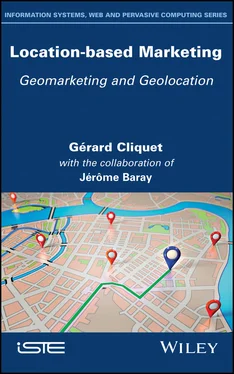Why expand the already vast field of geomarketing? In fact, this term was coined in France by the professional world when eponymous software spread to companies and local authorities; the technical dimension is therefore strong.
Wikipedia gives this definition: “Geomarketing is the branch of marketing that consists of analyzing the behavior of economic individuals taking into account the notions of space.” 1 And the same source confirms this technical side:
Geomarketing is present in various applications, such as studies of trading areas, store location studies, potential studies, sectorization, optimization of direct marketing resources (phoning, ISA, direct mail, etc.), network optimization, etc. Geomarketing frequently uses Geographic Information Systems (GIS) to process geographic data using computer tools.
Wikipedia also reports that
English speakers use the term Location Business Intelligence (or geo-business intelligence), which is more appropriate when the approach concerns marketing; but the discipline also applies to territory development in the context of socio-economic studies.
In local authorities, geomarketing has become an essential tool for the development of their territorial marketing for the management of public spaces from a social, economic or tourist perspective. But reducing geomarketing to location choices undoubtedly limits what will be the common thread of this book: the introduction of space into marketing decisions regardless of the sector of activity.
The objective of this book is therefore to broaden this field in a strategic perspective while addressing the main technical aspects of geomarketing in relation to the elements of the marketing mix for all companies. It will therefore take into account the specificities of sectors such as retailing, services and technology.
While mapping is certainly helpful, it is not the only means available to decision makers. The accelerated development of mobile marketing thanks to the rapid spread of smartphones reinforces the need to expand the field of geomarketing; indeed, can we imagine a smartphone without GPS? And even if the geolocation of smartphone owners poses legal problems, it is essential and many techniques have been developed to refine the accuracy of its geographical location.
Tracing a future perspective on the use of space in marketing decisions requires studying the historical trajectory of this idea. And even if it is possible to go even further back in the history of thought, as we will see, authors such as von Thünen, Hotelling, Reilly, Christaller, etc., in the 19th Century and in the first half of the 20th Century, whether economists or geographers, were able to trigger “spatial reflection”. This chapter, after a few definitions, traces the consideration of space in order to understand where the fields of geomarketing and spatial marketing come from before better understanding them.
Space has long been reduced to a mathematical notion: “a geometric concept, that of an empty environment” (Fischer 1981). Today we talk about social space, and the space treated here is in fact the market. But before coming to this notion, it is important to clearly identify all the variants of this concept of space. We talk a lot about territory, about countries (within a country in the sense of a nation) and about “spatial surface”. A space can be defined both in geographical terms and in relational terms (Duan et al . 2018), or even in historical or political terms (Paquot 2011). We then have a better understanding of the polysemy surrounding the notion of space. Space would be “a place, a reference point, more or less delimited, where something can be located, where an event can occur and where an activity can take place” (Fischer 1981), but to which it would be appropriate, in order to conceptualize it, to associate all the spatial practices of individuals (Lefebvre 2000) thus showing the close relationship between individuals and space (Fischer 1997). However, this relationship is currently undergoing major upheavals due on the one hand to societal changes (Levy 1996; Oliveau 2011) and on the other hand to extremely rapid technological change.
The territory has received several definitions resulting from two different meanings: a first one defines a territory as a place where a population resides, while a second one, more precise and legal, not to say more political, considers the territory as a place where power is exercised that can be justly political or judicial (Paquot 2011).
From these two meanings, definitions will be added that are increasingly out of step with each other. This drift may also explain some misunderstandings, with the State preferring to put forward the second meaning, favoring time over geographical space in order to establish its domination, when the people understand the first one which prefers living space over the time of power. It is then easier to understand why historians and geographers do not necessarily speak the same language when describing territories.
A country is a French administrative category defined by the law of February 4, 1995, on guidance for spatial planning and development (LOADT), known as the Pasqua law, and reinforced by the LOADDT (known as the Voynet law) of June 25, 1999. But it is now prohibited to create new countries (article 51 of law no. 2010-1563 of December 16, 2010, on the reform of local authorities). A country is defined as follows:
A territory that presents a geographical, economic, cultural or social cohesion, on the scale of a living or employment area in order to express the community of economic, cultural and social interests of its members and to allow the study and implementation of development projects.
Although considered as an administrative category, a country is neither a local authority, nor a canton, nor an EPCI ( Établissement public de coopération intercommunale ) and therefore does not have its own tax system. A large part of France is thus composed of “countries” resulting from contracts concluded between municipalities; this is of particular interest to rural areas.
The spatial surface is in fact a rather vague concept, but it expresses the difficulties resulting from the spatial heterogeneity encountered in certain spaces, due to discontinuities resulting from irregular borders, for example between regions, peninsulas or real inner holes. This heterogeneity can make the valuation of house prices very complex. This idea was applied to define house prices in the Aveiro region of the Ílhavo district (Portugal) (Bhattacharjee et al . 2017).
1.2. From geomarketing to spatial marketing
After describing the evolution of spatial marketing and placing it in the midst of other disciplines, it will be necessary to define this field, then to specify its differences from geomarketing, before identifying its content.
1.2.1. Spatial marketing: between economics and geography
It all starts with the development of the location theory of economic activities. Thomas More defended, as early as 1516 in his book Utopia , the need to divide the city into districts to accommodate each a market (Dupuis 1986). In his economic writings, Turgot (1768) posits three principles of the theory of store location:
– the centrality of the points of sale;
– the demographic threshold for the establishment of businesses, the existence of a sufficient market;
– the grouping of purchases.
On a more methodological level, von Thünen (von Thünen 1826), considered as the “father of location theories” (Ponsard 1988), then explains that “the optimal locations of agricultural activities are such that in every part of the space the land rent is maximized”. He thus founded the spatial economic analysis which he would later rely on to design his industrial location models at the beginning of the 20th Century (Weber 1909), which in turn would be used to model the expansion or spatial development of retail chains (Achabal et al . 1982). We can thus see how, in terms of the use of space in economic and managerial theories, progress has taken time.
Читать дальше












